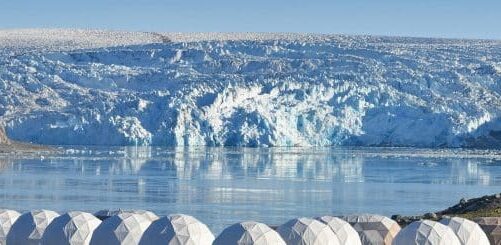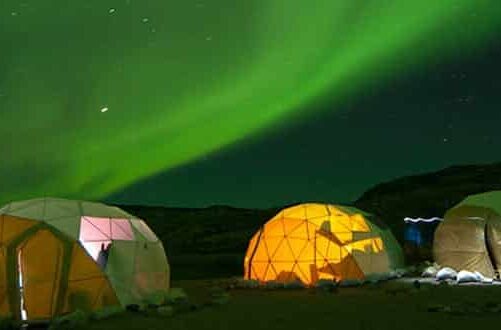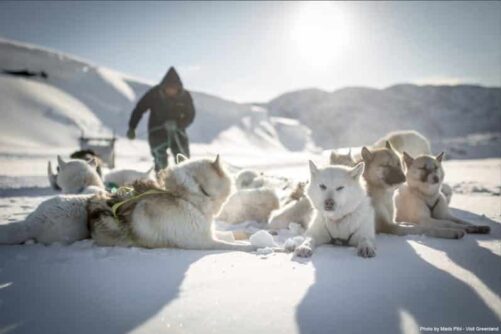

The Greenland shark: 7 facts about the half-blind and long-living creature of the Arctic waters
Jump to chapter
Published: 07/03/2022
Reading time: 4 minutes
The Greenland shark is known by many names: The gurry shark, the grey shark, or if you ask the Inuits, it is called Eqalussuaq which means shark or big fish in Greenlandic. In the scientific vocabulary, it goes by Somniosus Microcephalus. Lastly, it also has a reputation as “the sleepy shark” since it moves very slowly.
In this article, we stick to calling it the Greenland shark. Read on and learn seven facts about the mysterious creature that swims in the icy Arctic waters.
1. The lifespan of the Greenland shark
So how old can the Greenland shark get? It is said they are the longest-living vertebrate known to science. However, they are extremely difficult to observe since they live in total darkness in the very deep water. Therefore, their lifespan remains something of a mystery.
Scientists believe the Greenland sharks have a life expectancy of at least 272 years up to around 400 years – give and take. These studies are based on analysis of the shark’s eye tissue, just like rings on a tree. Nonetheless, the exact lifespan hasn’t been verified.
The reason for their longevity is still unknown, but scientists link it to their slow way of living.

2. The size of the Greenland shark
The Greenland shark can grow up to 7,3 meters (24 feet) long and weigh around 1,2 tonne (2,645 pounds). That is longer than the great white shark! However, it is common that their size is around 3 to 5 meters long.
With a big size comes a big set of teeth. The Greenland shark’s gap contains between 48 and 52 pointed teeth in the upper jaw and the same number in the lower jaw, but here the teeth protrude outwards and inwards. The teeth of the upper jaw function to hold the prey, while the lower jaw is used to cut.
3. Half-blinded in the darkness
As mentioned, the Greenland shark thrives deep down in the darkness. It can actually dive down to incredibly 2.8 kilometers (9000 feet) below the surface!
They have a bad sight due to a parasite called Ommatokoita elongata. This little parasite latches onto their eyes, grows, and eventually damages their cornea by leaving scars and infection which makes them almost blind.
But who needs a good sight, when you have an excellent sense of smell and can detect muscle movement around you?

4. Constant motion in slow motion
The Greenland shark’s top speed is a maximum of 2.9 kilometers per hour. Therefore, it is speculated that it can only catch seals while they sleep. The Greenland shark has the lowest swimming speed and tail stroke frequency of all sharks and fish species.
The shark does not suck in the water itself to excrete oxygen but absorbs oxygen when the water passes through the gills. The shark simply drowns if it is not in constant motion.
5. The colder the water, the happier the Greenland shark
All sharks are cold-blooded, but the Greenland shark takes it to the next level. It is the only shark species that tolerate the freezing conditions in the Arctic waters all year long. They are made to thrive in freezing cold water because of their low body temperature and their tissues that contain chemical compounds which function as anti-freezing.
Their body temperature is between minus one to plus five degrees Celsius. That limits the speed of blood circulation and thus the oxygen uptake, which slows down their metabolism. The slow metabolism is perhaps the explanation for the shark’s slow growth, aging, and slow movements.
Besides the Arctic Ocean, the Greenland shark is also present in the very North Atlantic and Russian High Arctic.

6. Is the Greenland shark dangerous?
According to Inuit legends, several kayaks have been attacked by the Greenland shark in the past. With that said, there is no evidence of these legends, and history and statistics prove them to be non-confrontational. But on that note, the size and strength of the shark are definitely capable of taking a human life.
The only proven danger of the Greenland shark is if humans consume their skin. The skin is poisonous and can make humans sick and cause diarrhea, vomiting, stumbling, and convulsions. In very rare cases even kill humans. This is only if the skin is not probably prepared or dried for several months. It is also sometimes used as a delicious snack for sled dogs!
7. Declining population
Until the 1960s, the Greenland shark was captured and used for the extraction of liver oil, until synthetic oils took over the market. Today, the population of the Greenland shark is declining.
It is often a by-catch in fishing nets, and a reduction in by-catch is therefore crucial to conserving this unique species. As the Greenland shark is only thought to breed when they are over a century old, the bycatch of old Greenland sharks can have an effect for many decades.
Do you admire the creatures in the Arctic waters?
Unfortunately, we do not offer tours deep down in the darkness to watch the Greenland shark. But we do offer amazing whale watching tours in Greenland! See our whale watching tours here.
If you would like to read about other amazing creatures in the Arctic waters, read our article about the humpback whale here.
Below, you can see a hunting video in Greenland where they catch a Greenland shark through the ice:
















































































